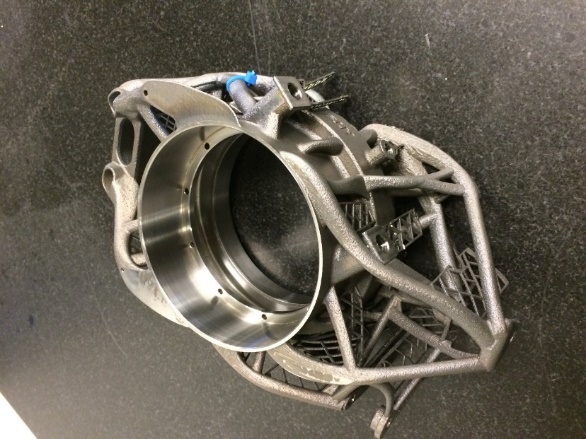Professors Jan Torgersen and Filippo Berto highlight how new technologies are helping to develop the next generation structural components
In the midst of continuous digitalisation of manufacturing processes, modern short product life cycles and the ever-growing need for high performance, for example, the requirement to fabricate stiff and low weight products within only a few simple production steps, we face stringent requirements on both time and sophistication of modern structural design and property prediction. For digital production and advanced components of the future, conventional design methods, structural evaluation routines and production techniques fail to fulfil necessary requirements for structural complexity, the complexity required to boost modern products to the next performance level. The autonomous production in the ambit of the 4th industrial revolution paired with the need for parts that challenge today’s production constraints necessitates the use of enabling technologies such as additive manufacturing (AM). These technologies allow the direct conversion of digital designs into physical products within one production step and completely autonomous avoiding setup time and the use of tools. This digital workflow prompts a product development process and structural property prediction without physical testing, only utilising advanced simulation-based methods for both, structural optimisation and failure prevention.
The Additive Manufacturing dilemma
With AM, however, a significant problem arises. In conventional manufacturing technologies, one utilises a given material with defined and well-known material properties and removes material to obtain the desired geometry. In contrast, the material properties in AM evolve during the fabrication process. Geometry and material properties are closely related, every change in the geometry will change the way the AM machine performs its building routine, affecting the tool path and ultimately the properties of the resulting solid. Parts are no longer isotropic, in some cases not fully dense, surfaces are rough and there is a high chance of inclusions, impurities and in homogeneities, all related to the underlying manufacturing strategy, which, in turn, is dependent on the input geometry.
We face a dilemma; on the one hand, we possess a technology that is undoubtedly of high potential and can fulfil the needs of modern digital manufacturing, enabling unprecedented complex designs in an economic fashion. On the other hand, we cannot guarantee that respective parts will withstand complex loading scenarios because of the still poor and/or poorly known material properties as well as the insufficiently accurate failure criterions allowing their prediction.
In our research, we tackle both aspects of this dilemma. Utilising modern AM, we aim to create digital material designs fulfilling stringent requirements of aerospace, automotive and biomedical applications. We employ the latest topology optimisation routines and develop them further for better usability and better interaction with the AM manufacturing process chain. Specifically, we work on improving the interfaces between the topology optimisation routine and its compatibility to solid modelling. This will enable easy downstream processing. Further, we aim to optimise the tessellation routines, streamlining the entire development process and allowing a smooth transition between the individual steps of the process.
Further, we aim to optimise support structures. These are necessary for attaching AM parts to the building platform to ensure dimensional accuracy. We consider these support elements as part of our optimisation routine maximising speed and minimising failure already happening in the building process.
Quality assurance
We further develop a sound experimental and theoretical understanding of the fatigue and fracture behaviour of these advanced geometric complex components. To date, this assessment and the quality assurance of AM components is not accurate as microstructural features, as well as the specific mechanical/cracking behaviour of AM materials, cannot be modelled effectively due to their complex microstructural configuration. For complex AM components, no specific design criteria are in place considering stress concentration phenomena arising from geometrical discontinuities/features. Additionally, no fatigue data generated by testing such geometrical discontinuous AM metals can be found in the technical literature. We, therefore, aim to fill this knowledge gap allowing future applicants to take full advantage of the unique features of AM, which is key to integrate this promising technology in everyday manufacturing. Drawing from extensive expertise in the development of modern fatigue assessment criteria, our group aims to contribute to the fundamental understanding of the mechanical/cracking behaviour of AM materials subjected to fatigue loading as well as the integration of this knowledge in an innovative design methodology. The key feature of this unifying approach is the consideration of microstructural features (such as porosity, grain shape, defect morphology, etc.) of the material near crack initiation locations.
Due to the geometric complexity of AM advanced components (see Figure 1) and materials related structures naturally have a large surface to volume ratios. Large areas are exposed to and interact with the surrounding, which is even further enhanced through the typically rough surfaces AM many parts exhibit. This can be beneficial, as for example in biomedical applications, where cells tend to easily attach to the porous and rough structure of AM fabricated implants. However, this exposure can also lead to detrimental effects such as corrosion, environmental induced embrittlement or wear through friction. Independent from the intended use of the part, the ability to tailor surface characteristics and surface material properties of advanced geometric complex components will allow for the ultimate design freedom. Our group combines AM with thin film deposition reaping these technologies’ advantages while bypassing their limitations. We aim to equip parts with mechanical and electrical properties that are conventionally not achievable, not in costs nor in performance. This way, we aim to introduce key surface properties ranging from corrosion to scratch resistance, hydrophobicity all the way to enhanced flow characteristics. These performances shall rise from a geometric and material optimisation across multiple length scales, from nano to macro.
In summary, our group works on the forefront of three emerging technologies, simulation-based design and property prediction, additive manufacturing and thin film deposition. All fields together will enable novel digital materials and designs, their direct conversion into physical parts as well as the guarantee of their compliance through properly defined and tailored failure criterions. This interdisciplinary and integrative research will streamline the digital manufacturing workflow all the way from the idea to the final product and will enable designers and engineers to better transform their ideas into reality.
References:
1 P. Lazzarin, F. Berto: “Recent developments in brittle and quasi-brittle failure assessment of engineering materials by means of local approaches”, Materials Science and Engineering: R: Reports, 75, 2014
2 J. Torgersen, XH. Qin, Z. Li, A. Ovsianikov, R. Liska, J. Stampfl: “Hyrdogels for Two-Photon Pollymerization: A Toolbox for Mimicking the Extracellular Matrix”, Advanced Functional Materials 23 (36), 2013
People:
Mirco Peron (PhD student):
mirco.peron@ntnu.no
http://www.ntnu.edu/employees/mirco.peron
Javad Razavi (PhD student):
javad.razavi@ntnu.no
http://www.ntnu.edu/employees/javad.razavi
Filippo Berto
Jan Torgersen
Professors
Norwegian University of Science and Technology
Filippo.berto@ntnu.no
jan.torgersen@ntnu.no
www.ntnu.edu/employees/filippo.berto
www.ntnu.edu/employees/jan.torgersen
Please note: this is a commercial profile











